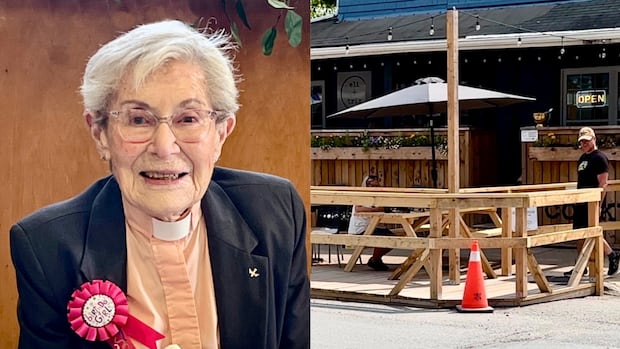Baby ospreys rescued from burning nest reunited with parents

Two baby birds barely bigger than a ball of feathers have been reunited with their parents in a brand new home after being rescued – smoky and scorched – from their fiery nest in Musquodoboit Harbor, NS two weeks ago.
The reunion was a collaboration between firefighters, the rescue organization Hope for Wildlife, Nova Scotia Power and the Department of Natural Resources.
The fluffballs’ misfortune was likely fueled by an unlikely culprit: their parents.
Steve Stubbert, the captain of the Musquodoboit harbor fire station, said the crew received a report of a utility pole on fire on June 26.
Ospreys often build their nests on top of power poles. It’s generally not a problem unless more than one wire is touched at a time, Stubbert says.
“At one point, with the nest complete and babies in the nest, they put a stick across that connected two wires and it made an arc and caused the nest to catch fire.”
Parents ‘a bit helpless’
Stubbert says the parents flew around frantically when the nest burned.
“Occasionally they landed in the nest, but could only stay in the nest for a few seconds,” he says. “They didn’t seem to be able to lift the chicks out and do anything for them. So they were a bit helpless, even though they did their best to cope.”
When Nova Scotia Power arrived to shut off the electricity, crews removed the chicks from the nest, put them in a box, and handed them over to the fire department. Then they had to destroy the flaming home of the ospreys.
Stubbert says he placed the birds in a quiet area of the firehouse and wrapped them in a blanket.
“They had lost a little bit of that downy feather that they have when they’re really young. They had kind of scorched them out. So they had that smell of burnt hair.”
Someone from Hope for Wildlife arrived within an hour to take care of the babies.
Hope Swinimer, the sanctuary’s director, says the birds were only about two weeks old because they still had their egg teeth, a small protrusion on the beak that helps them break their egg so they can emerge.
The birds appeared unharmed, Swinimer says, and her team fed the chicks bits of fish to help them gain weight and get stronger.
Meanwhile, Department of Natural Resources employees were busy building a new nest for the family as close to the old one as possible.
Nova Scotia Power built a new pole close to the old one, with a platform to house the nest. The new pole is for ospreys only and is not connected to any power lines.

On Saturday morning, a Hope for Wildlife worker placed the chicks in their new home, using a Nova Scotia Power aerial work platform.
But everyone had one concern: what if the parents didn’t come back?
Kris Lambert, a wildlife technician with the Department of Natural Resources, spent all day guarding the nest. He saw the parents around 5 p.m., but they ignored the new nest and instead tried to build on the charred post again.
“It went up and down. We were excited, nervous, anxious,” he says.
Finally, at about 7:00 pm, the female sat on the nest for a few minutes, and by dusk that evening she brought her chicks their first meal in their new home, not leaving their side all the next day.
“Those parents stayed close and didn’t hesitate when the babies came back,” says Swinimer. “It just shows what a great bond there is between mom and babies of all kinds.”
Stubbert says he was surprised to find out how the chicks’ ordeal ended.
“I assumed that Hope for Wildlife would be able to take care of them and get them to the point where they might be able to survive on their own. But I by no means expected there to be a concerted effort to get them back with their parents in the same area in a better-than-ever nest,” he says. “It was nice to see.”



